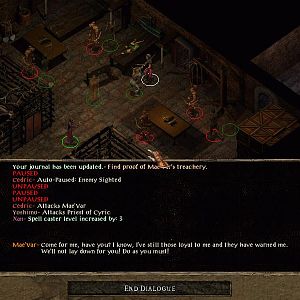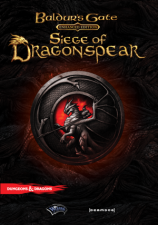-

- Forums
- Chatrooms
- Gallery
- Gameplay Videos
- Upload
- Articles
- Mod Reviews
- Shop SP: Games, Movies, Books

Planning the Perfect Party | Lord Markus | Stygar | Akutagawa | Alliria | Tithian | Lady Elanna |
PLANNING THE PERFECT PARTY
Roles – A Precursor to Further Planning
A good party is one where each party member fulfills certain roles that allow for an efficient and effective strategy. Here are some roles that often crop up in IWD2:
When I summarize each character below, I often describe their roles as 'Primary Tank' or 'Secondary Healer', etc. There's reasons for this. There's some thought that characters should built as jack of all trades, able to do a lot of things, all at once, healing, fighting, spellcasting, etc. The contrary school of thought is that specialization can serve a character better. In each combat round, a character can only perform one action, therefore it is better to hone the actions that the character will perform most often, without having to saddle the character with abilities that are performed less frequently.
I would suggest that there's a room for a happy compromise, a move towards specialization but with some accommodation for more versatility. Sometimes a character should specialize in a certain role, and perform actions that will relevant to that role first and foremost, but ready to act in a secondary or tertiary role only when circumstances merit it. For example, I designate my Paladin as 'Primary Tank' and 'Tertiary Healer'. My Paladin should as a matter of routine be swinging away with his sword as a first priority. Lay on Hands is useful, but really only should be called upon when the Paladin is closest to a wounded character, and the Cleric or Druid may not be able to reach that wounded character in time. In other words, concentrate on what your characters should do most often, but include a little versatility for situations that warrant it.
Plan each character out
This will save you a lot of grief later on. Once you envisage which characters are going to play what roles, plan out your characters accordingly. What items are they going to wear, what stats will you raise, what feats are you going to choose for them, etc.
Stats and Feats
For stats, one thing to keep in mind is that raising character stats will only make a difference when the stat reaches an even number integer. For example, if strength is raised from 16 to 18, it will mean another +1 to attack bonus, damage, and carrying capacity. If you don't take it any further than just adding 1 to strength for a strength score of 17, it makes absolutely no difference from having a strength score of 16. A party that levels up to 20th level, which can happen in Tactics with the help of Ease of Use and some patience on your part, will get 5 bonus stat points to add to each character. +4 to one stat will obvious make a difference. The question is what to do with that lingering 5th stat bonus point. The key is to search for an item or spell that provides an odd number bonus to make the difference. For example, suppose a Sorcerer makes it to 20th level. 5 points added to Charisma will mean +2 to saving throw difficulty class, and more spells that can be cast each day. That 5th point to Charisma will not make a difference ... unless ... you find an item that provides an odd number, like a Master's Robe (+3 Charisma). So ... the +5 bonus accumulated over 20 levels combines with the +3 bonus from the Robe to provide a +8 bonus to Charisma.
It goes without saying, put your bonus stats where they'll count for each character. Charisma for Sorcerers, Dexterity for Rogues, etc. Same thing goes for feats, Improved Critical for warriors, Spell Focus for spellcasters, etc.
Inventory
Inventory also requires careful planning. But a few general guidelines are in order.
Be careful about equipping more than one item with bonuses that will not stack. This may not represent the most efficient way to make use of the limited slots in your inventory. Choose one and look for another item that provides something else. Item bonuses that do not stack include:
Some bonuses will stack however, so help yourself. These include:
Look for ways to maximize your Armor Class in Tactics, from all four sources if you can, armor, shield, dexterity, and generic. If your character has high dexterity (by your design or by mix/maxing), leather or similarly light armor provides an option. If the character has lower dexterity, look for heavier armor.
As a general rule of thumb, most characters should make use of all 4 of their available weapon slots, according to this fashion:
Primary Weapon set: Your main damaging weapon and a shield. There are exceptions to this that can be justified, but Tactics is intense enough to encourage you to raise your armor class as much as possible.
Secondary Weapon set: A weapon that provides an alternative type of damage plus a shield. For example, if the character's primary weapon does slashing or piercing damage, then keep a blunt weapon in store in your second set. The reason for this is that the monsters in IWD2 are quite variable in what kinds of damage they're vulnerable to, or immune to. Come prepared.
Third Weapon set: A missile weapon, for when enemies are at long range.
Fourth Weapon set: A two-handed weapon when you want to reach over a comrade in tight quarters.
For detailed explanations of my characters, the end results of my planning, they are as follows:
Lord Markus of Helm – An Aasimar Paladin of Helm / Fighter
Stygar Storm Axe – A Shield Dwarf Battleguard of Tempus
Akutagawa – A Human Monk
Alliria – A Half-Elf Druid/Ranger
Tithian – A Drow Wizard/Rogue
Lady Elanna – A Human Sorceress


